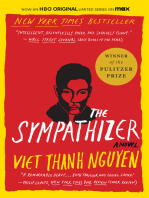0 ratings0% found this document useful (0 votes)
15 viewshw2 Help2
hw2 Help2
Uploaded by
tauseefCopyright:
© All Rights Reserved
Available Formats
Download as PDF or read online from Scribd
hw2 Help2
hw2 Help2
Uploaded by
tauseef0 ratings0% found this document useful (0 votes)
15 views5 pagesOriginal Title
hw2-help2
Copyright
© © All Rights Reserved
Available Formats
PDF or read online from Scribd
Share this document
Did you find this document useful?
Is this content inappropriate?
Copyright:
© All Rights Reserved
Available Formats
Download as PDF or read online from Scribd
Download as pdf
0 ratings0% found this document useful (0 votes)
15 views5 pageshw2 Help2
hw2 Help2
Uploaded by
tauseefCopyright:
© All Rights Reserved
Available Formats
Download as PDF or read online from Scribd
Download as pdf
You are on page 1of 5
Mache Learni
An Arti f dal
[Vhel sk
(983
gt
Inte Usgene App poath
Carbonell Mitchell.
15
LEARNING EFFICIENT
CLASSIFICATION PROCEDURES
AND THEIR APPLICATION TO
CHESS END GAMES
ABSTRACT
nis deating with
rae numbers of exam
another
developed
resulls, ‘The paper ends
‘specification of relevant
system is
observed
15.1 INTRODU
ON
‘ules discovered in this way as compare
‘ke same task, (in one case, the clas
‘est alternative method that I could devise.)
is five times as fast as
463
r
“ CHAPTER 15: LEARNING EFFICIENT CLASSIFCATION PROCEDURES | QUINLAN a5
152 THE INDUCTIVE INFERENCE MACHINERY
tee shown
‘dark’ and “rea
sections, The first, Set
jing System (C15).
this model
used to describe object
ery of the attributes th
466
Figure
belonging
in such eases the
However, itis generally desi
were not used in
set of example:
two object
CHAPTER 15: LEARNING EFFICIENT CLASSIFCATION PROCEDURES
r
short, blond blue: +
tal blond, Be: +
tributes are inadequate for
fe that the troe be able to classify objects wh
‘QUINLAN
dark red
nveyed by this message.
and p~ tespectively, the expected informat
p* logs pt — po
5, $0 that p+ becomes the propo
MIC) to denote this eal
fontent of a message from o deci
4) = 0. Now consider as before the po
‘st next. The paral decision tee is 9
Skribowe A are mnt
mn set C of objects we can approximate these probabi
487
blond
on of objects in C
n of the expected
a set C of objects, and define Mi
‘le choice of A as the
ywn in Figure $5-4. The values Aj of
268 CHAPTER 15: LEARNING EFFICIENT CLASSIFCATION PROCEDURES
attribute
A
ea ea
C1 C2
igure 154:
til decision toe
Toil
the example given earlier
M(C)= — 378 logy V8 ~ Si
anch:
(3 ~ 2/3 log 23 = 0.918 bits
fon content
= 5/8 0.971 + 3/8 * 0.918
this ateibute is:
0.954 — 0.951 = 0.003 bits
which is ne
previously. The branches
the n. wh
“objects und so requires 1
= 38 0+ UBM O + TT
We have:
en
igible, The tree arising fromm testing the second
‘with 3 objects) and "red"
he branch for “blond” co
954 - 0.5 =
bute was giver
object) requite
ned 2 “plus” and 2
0.454
‘QUINLAN 469
7~
tl, on, brown: = shot blow, +
tie =| Short arte =
short, blond, brown: =
1s on the set of objects C (such as determining the
ihjects with valuc A; of altribute A) can be performed clticien
practice that C has to be kept in fast memory. What happens
? One way around the difficulty is given by the version
fh C is digested one object at
two sets $ and G
specific and
far; these
lecision tree
random a subset of the given
repeat
© form a rule to ex
© Find the exceptions t0
0 fo
the n
Uni there are no exceptions to the rule
the current window
is rule in the remaining instances
the current window and the exceptions to
new window
le generated frot
it
ends when a nile is formed that has no excep
J fall of C. Two diferent ways of forming 2 new window have been Wied
Se ist, the current window is enlarged by the ad
1S. and 50 the window grows
‘als with a ication probh
2.000 objects for which a correct des
19794}. The main findings were:
mm tree contained 48 nodes (Quinlan,
L
a70 CHAPTER 15: LEAANING EFFICIENT CLASSIFCATION PROCEDURES | QUINLAN. S oa
The
converge rapidly; typically only 4 iterations were required to
1 eorreet decision tee.
‘#1 was possible to develop a correct tree from &
only as ion of the 2,000 objects.
ocess was nol very sensitive to parameters such as
dow size.
474,000
‘The firs
tributes. 18 of these were
window containing
initial win
the difficulty of the problem as defined by the
ven in the introduction,
have enabled 13 to discover correct
jon problems,
‘These features, particularly the
trees for some very large clas
the only move the black ki
15.3 THE LOST N-PLY EXPERIMENTS, she rook
IDS has been to discover classification rules for part of
ik versus (black) king-knight. The relations com
for n=2 and n=3; the 4-ply
One application of
the end game (white) ki
last O-ply if and only if
a the king is in checkmate, or
b, the knight has been captured, the position is not stalemate, the whit
rook has not been captured and the black king cannot retaliate by
capturing it
ibutes was meant
task. For ex
if the position was of one
imtended to detect some
‘As expected, these new
the classification problem than were
rie predecestors. They had the effect of
lost n= I ply.
Tost n-ply (n even) iff all possible black moves
ply
n and S0-move rules of chess, but are quite
IF attributes ean be found
ion task and that are also relatively cheap to com
are adequate f
pute, then the «|
bee faster than the minimay search of the gare ee.
n_ways of placing the four pieces to form #
this
re the knight of whit
ate).
use, for instance, the white king ei
fon.) These counts include many s)®
metric variants of essentially the same position, and when these are removed tf | For the purposes Parison, all methods were implemented in Pascal
You might also like
- The Subtle Art of Not Giving a F*ck: A Counterintuitive Approach to Living a Good LifeFrom EverandThe Subtle Art of Not Giving a F*ck: A Counterintuitive Approach to Living a Good LifeRating: 4 out of 5 stars4/5 (5891)
- The Gifts of Imperfection: Let Go of Who You Think You're Supposed to Be and Embrace Who You AreFrom EverandThe Gifts of Imperfection: Let Go of Who You Think You're Supposed to Be and Embrace Who You AreRating: 4 out of 5 stars4/5 (1103)
- Never Split the Difference: Negotiating As If Your Life Depended On ItFrom EverandNever Split the Difference: Negotiating As If Your Life Depended On ItRating: 4.5 out of 5 stars4.5/5 (870)
- Grit: The Power of Passion and PerseveranceFrom EverandGrit: The Power of Passion and PerseveranceRating: 4 out of 5 stars4/5 (597)
- Hidden Figures: The American Dream and the Untold Story of the Black Women Mathematicians Who Helped Win the Space RaceFrom EverandHidden Figures: The American Dream and the Untold Story of the Black Women Mathematicians Who Helped Win the Space RaceRating: 4 out of 5 stars4/5 (912)
- Shoe Dog: A Memoir by the Creator of NikeFrom EverandShoe Dog: A Memoir by the Creator of NikeRating: 4.5 out of 5 stars4.5/5 (543)
- The Hard Thing About Hard Things: Building a Business When There Are No Easy AnswersFrom EverandThe Hard Thing About Hard Things: Building a Business When There Are No Easy AnswersRating: 4.5 out of 5 stars4.5/5 (352)
- Elon Musk: Tesla, SpaceX, and the Quest for a Fantastic FutureFrom EverandElon Musk: Tesla, SpaceX, and the Quest for a Fantastic FutureRating: 4.5 out of 5 stars4.5/5 (474)
- Her Body and Other Parties: StoriesFrom EverandHer Body and Other Parties: StoriesRating: 4 out of 5 stars4/5 (830)
- The Sympathizer: A Novel (Pulitzer Prize for Fiction)From EverandThe Sympathizer: A Novel (Pulitzer Prize for Fiction)Rating: 4.5 out of 5 stars4.5/5 (122)
- The Little Book of Hygge: Danish Secrets to Happy LivingFrom EverandThe Little Book of Hygge: Danish Secrets to Happy LivingRating: 3.5 out of 5 stars3.5/5 (414)
- The Emperor of All Maladies: A Biography of CancerFrom EverandThe Emperor of All Maladies: A Biography of CancerRating: 4.5 out of 5 stars4.5/5 (272)
- The Yellow House: A Memoir (2019 National Book Award Winner)From EverandThe Yellow House: A Memoir (2019 National Book Award Winner)Rating: 4 out of 5 stars4/5 (99)
- The World Is Flat 3.0: A Brief History of the Twenty-first CenturyFrom EverandThe World Is Flat 3.0: A Brief History of the Twenty-first CenturyRating: 3.5 out of 5 stars3.5/5 (2270)
- Devil in the Grove: Thurgood Marshall, the Groveland Boys, and the Dawn of a New AmericaFrom EverandDevil in the Grove: Thurgood Marshall, the Groveland Boys, and the Dawn of a New AmericaRating: 4.5 out of 5 stars4.5/5 (269)
- Team of Rivals: The Political Genius of Abraham LincolnFrom EverandTeam of Rivals: The Political Genius of Abraham LincolnRating: 4.5 out of 5 stars4.5/5 (235)
- A Heartbreaking Work Of Staggering Genius: A Memoir Based on a True StoryFrom EverandA Heartbreaking Work Of Staggering Genius: A Memoir Based on a True StoryRating: 3.5 out of 5 stars3.5/5 (232)
- On Fire: The (Burning) Case for a Green New DealFrom EverandOn Fire: The (Burning) Case for a Green New DealRating: 4 out of 5 stars4/5 (74)
- The Unwinding: An Inner History of the New AmericaFrom EverandThe Unwinding: An Inner History of the New AmericaRating: 4 out of 5 stars4/5 (45)
- Cranial Nerves2011gyógytornászDocument46 pagesCranial Nerves2011gyógytornásztauseefNo ratings yet
- The Cranial NervesDocument28 pagesThe Cranial NervestauseefNo ratings yet
- IntroDocument66 pagesIntrotauseefNo ratings yet
- Data WarehouseDocument49 pagesData WarehousetauseefNo ratings yet
- HW 1Document10 pagesHW 1tauseefNo ratings yet
- Assignment 7editted PDF FreeDocument28 pagesAssignment 7editted PDF FreetauseefNo ratings yet














































